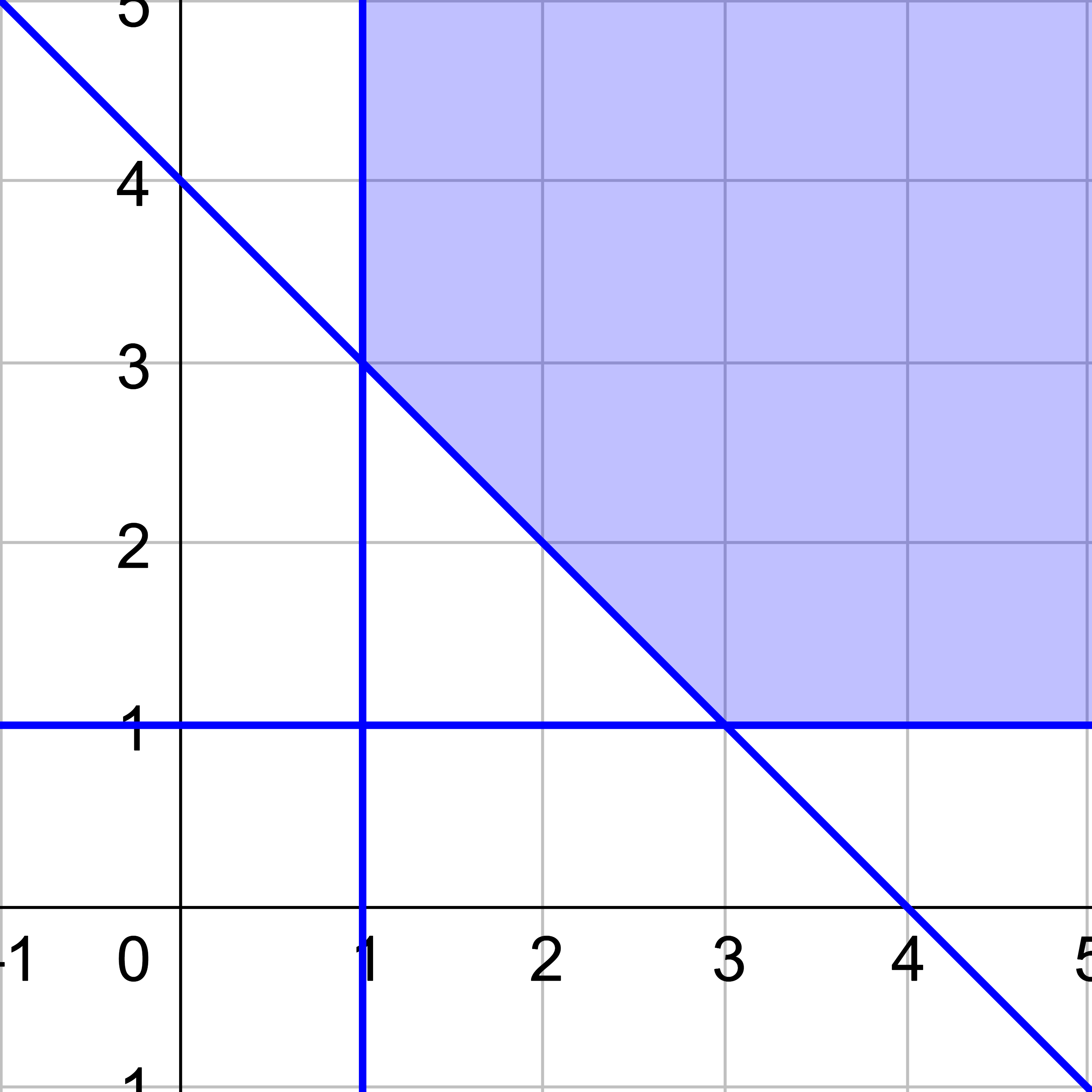Precalculus by Richard Wright
Precalculus by Richard Wright
Then you will call, and the Lord will answer; you will cry for help, and he will say: Here am I. Isaiah 58:9 NIV
Summary: In this section, you will:
SDA NAD Content Standards (2018): PC.6.1, PC.7.3

During WWII, liberty ships ferried war material from the USA to European allies. They were built in large quantities with a simple basic design. Organizers needed a way to optimize how ships were deployed and what was loaded on them. Similar problems requiring maximizing or minimizing encouraged mathematicians to develop a method called linear programming. Linear programming is an optimization strategy to find the maximum or minimum of an objective function based on constraints. The objective function is the function of which the maximum or minimum is desired. The constraints are a system of inequalities that limit the values that can be used in the objective function. Linear programming has been used by the United Kingdom for the selection of ships and transport aircraft to support deployment of their military assets.
Solve linear programming problems in two variables by graphing the constraints and finding the vertices of the solution area. The maximum or minimum of the objective function will be on one of the vertices, so substitute the vertices into the objective function to determine which point produces the maximum or minimum.
Find the maximum for C = 2x + y given \(\left\{\begin{align} y &≥ \frac{5}{9} x \\ y &≤ 13 \\ x &≤ 9 \\ x &≥ 0 \end{align}\right.\).
Solution
Graph the constraints (the system of inequalities) and find the vertices of the shaded area.
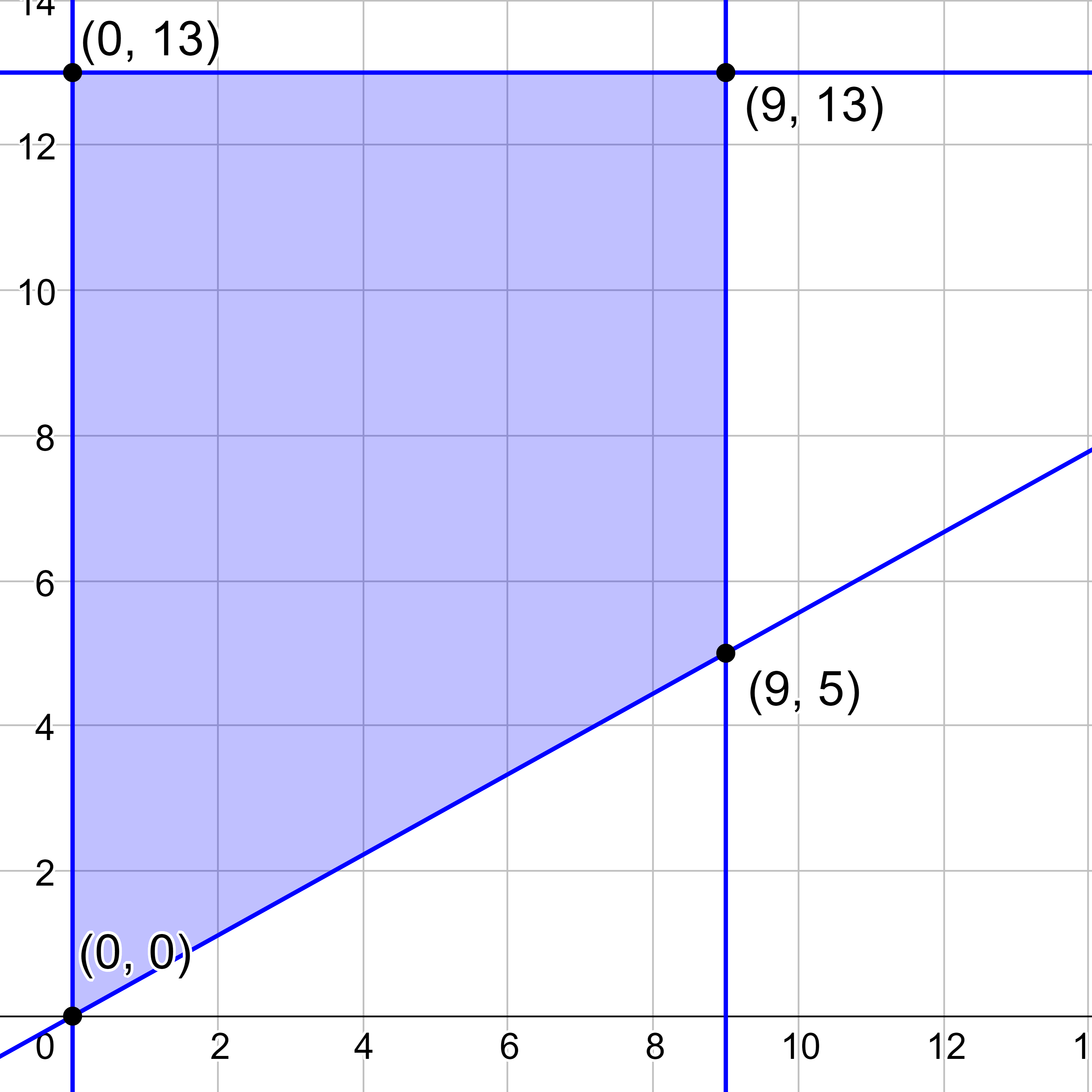
Substitute each vertex into the objective function and find which one produces the maximum.
C = 2x + y
(0, 0): C = 2(0) + (0) = 0
(0, 13): C = 2(0) + 13 = 13
(9, 13): C = 2(9) + 13 = 31
(9, 5): C = 2(9) + 5 = 23
The maximum is 31 and occurs at (9, 13).
Find the maximum of P = 3x − y given the constraints \(\left\{\begin{align} y &≤ -\frac{1}{2} x + 9 \\ y &≤ -2x + 18 \\ y &≥ 2 \\ x &≥ 4 \end{align}\right.\)
Answer
Maximum is 22 at (8, 2)
Sometimes the constraints do not form a closed shape. These systems on constraints are called unbounded. In unbounded systems, there can only be a maximum or a minimum, but not both because it is possible to pick points approaching infinity in some direction.
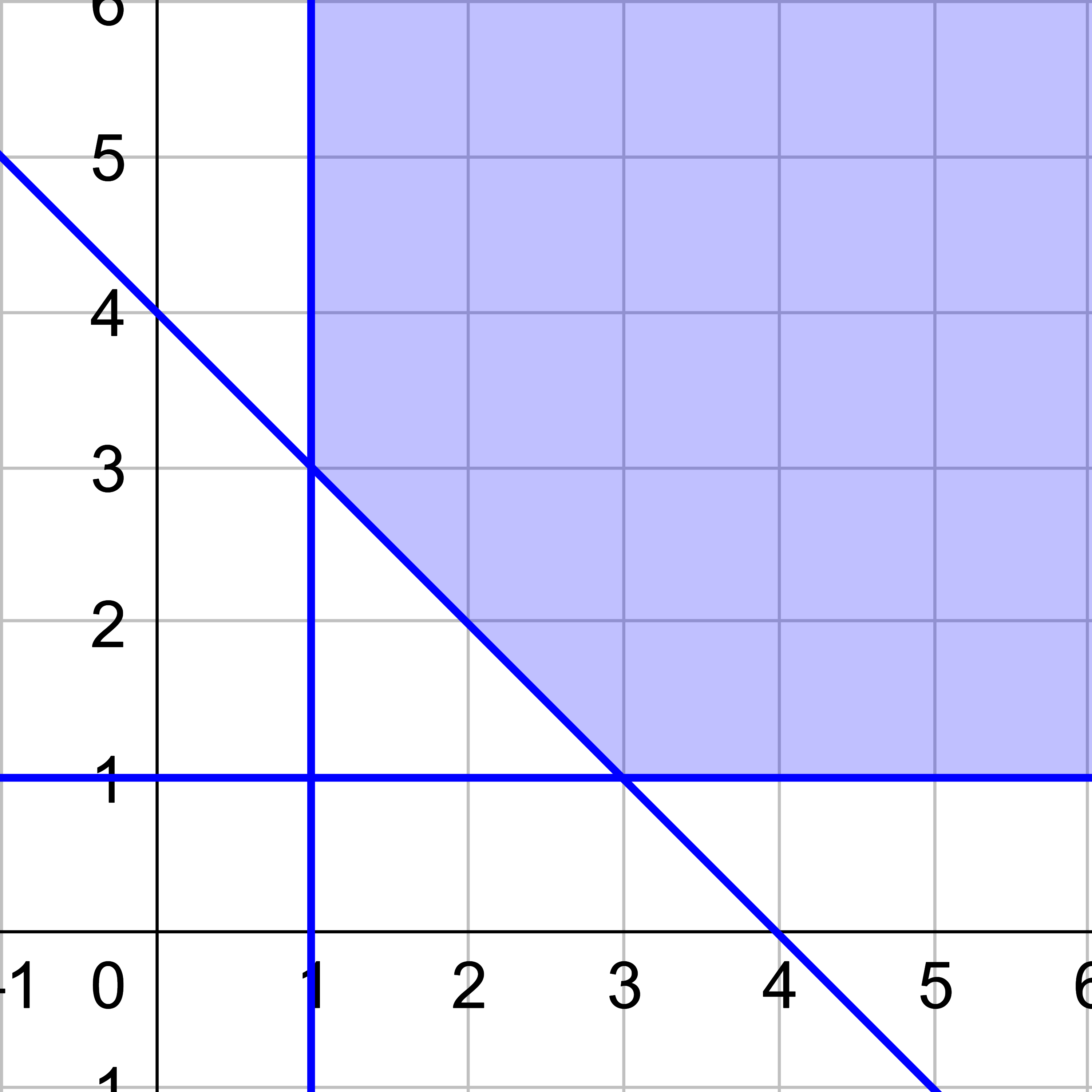
Find the minimum of the objective function C = x + 3y given the constraints:
$$ \left\{\begin{align} y &≥ 0 \\ x &≥ 1 \\ y &≥ -\frac{1}{2} x + 3 \end{align}\right. $$
Solution
Graph the system of inequalities and find the vertices of the shaded area.
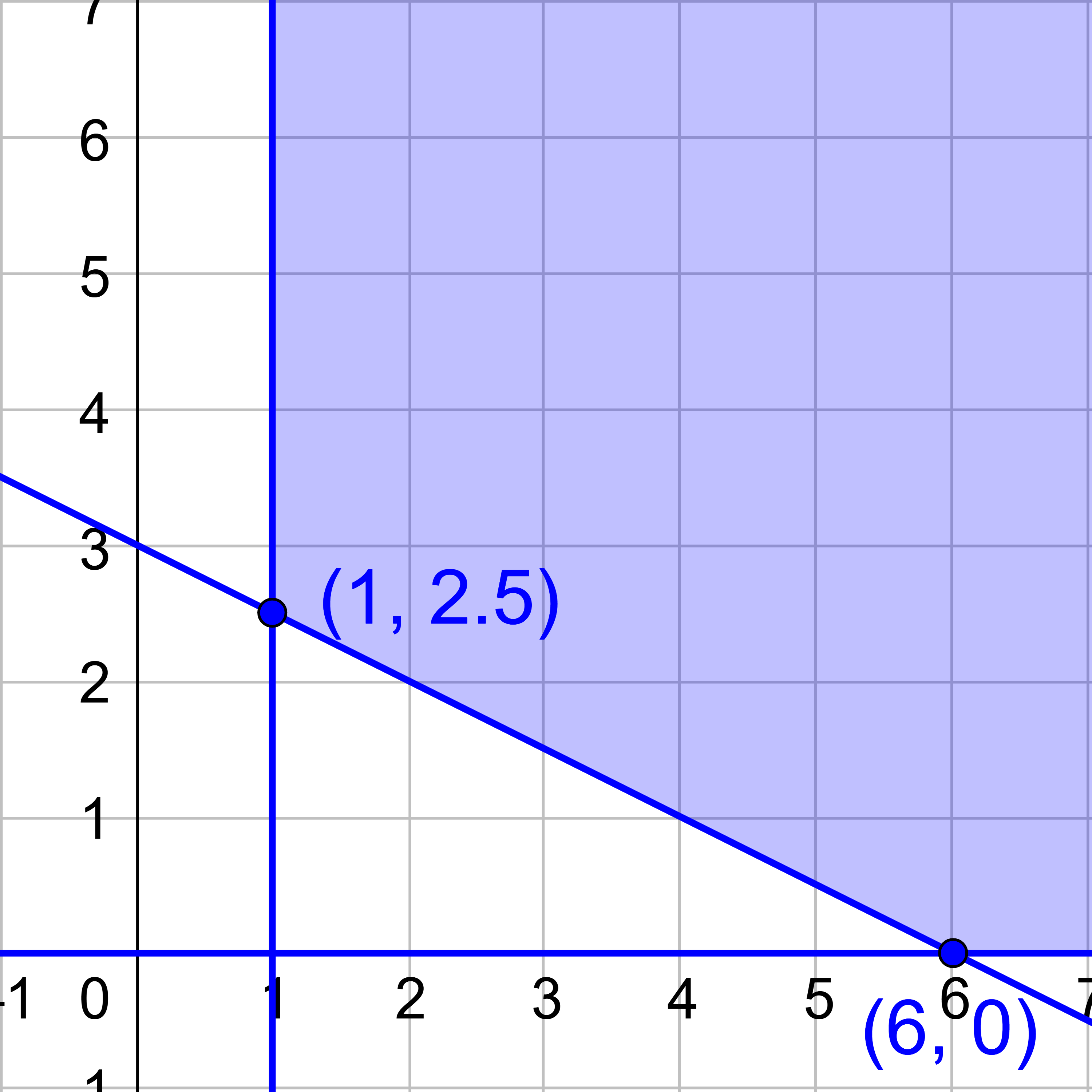
The vertices are (1, 2.5) and (6, 0). Try these in the objective function to find the minimum.
Try (1, 2.5).
C = x + 3y
C = 1 + 3(2.5)
C = 8.5
Try (6, 0).
C = x + 3y
C = 6 + 3(0)
C = 6
The minimum is 6 and occurs at (6, 0).
Find the maximum of the objective function C = 2x + y given the constraints:
$$ \left\{\begin{align} y &≤ 5 \\ x &≤ 5 \\ y &≤ -x + 7 \end{align}\right. $$
Answer
The maximum is 12 and occurs at (5, 2).
A small furniture manufacturer makes ornate chairs and fancy tables. It takes 3 hours to assemble and 1 hour to paint an ornate chair. It takes 2 hours to assemble and 1 hour to paint a fancy table. The factory has 36 man-hours for assembly and 24 man-hours for painting per day. The company makes a profit of $30 per ornate chair and $20 per fancy table. Use linear programming to determine the ideal number of chairs and tables they should produce per day, assuming that they are able to sell everything they produce.
Solution
Organize the constraint information into a table in order to write inequalities.
| Ornate Chair (x) | Fancy Table (y) | Total time available | |
|---|---|---|---|
| Assembly | 3 | 2 | 36 |
| Paint | 3 | 1 | 24 |
| Profit | $30 | $20 |
Write the constraints based on the table. Include x ≥ 0 and y ≥ 0 to indicate that the factory cannot produce a negative number of chairs and tables.
$$ \left\{\begin{align} 3x + 2y &≤ 36 \\ 3x + y &≤ 24 \\ x &≥ 0 \\ y &≥ 0 \end{align}\right. $$
Graph the constraints the find the vertices.
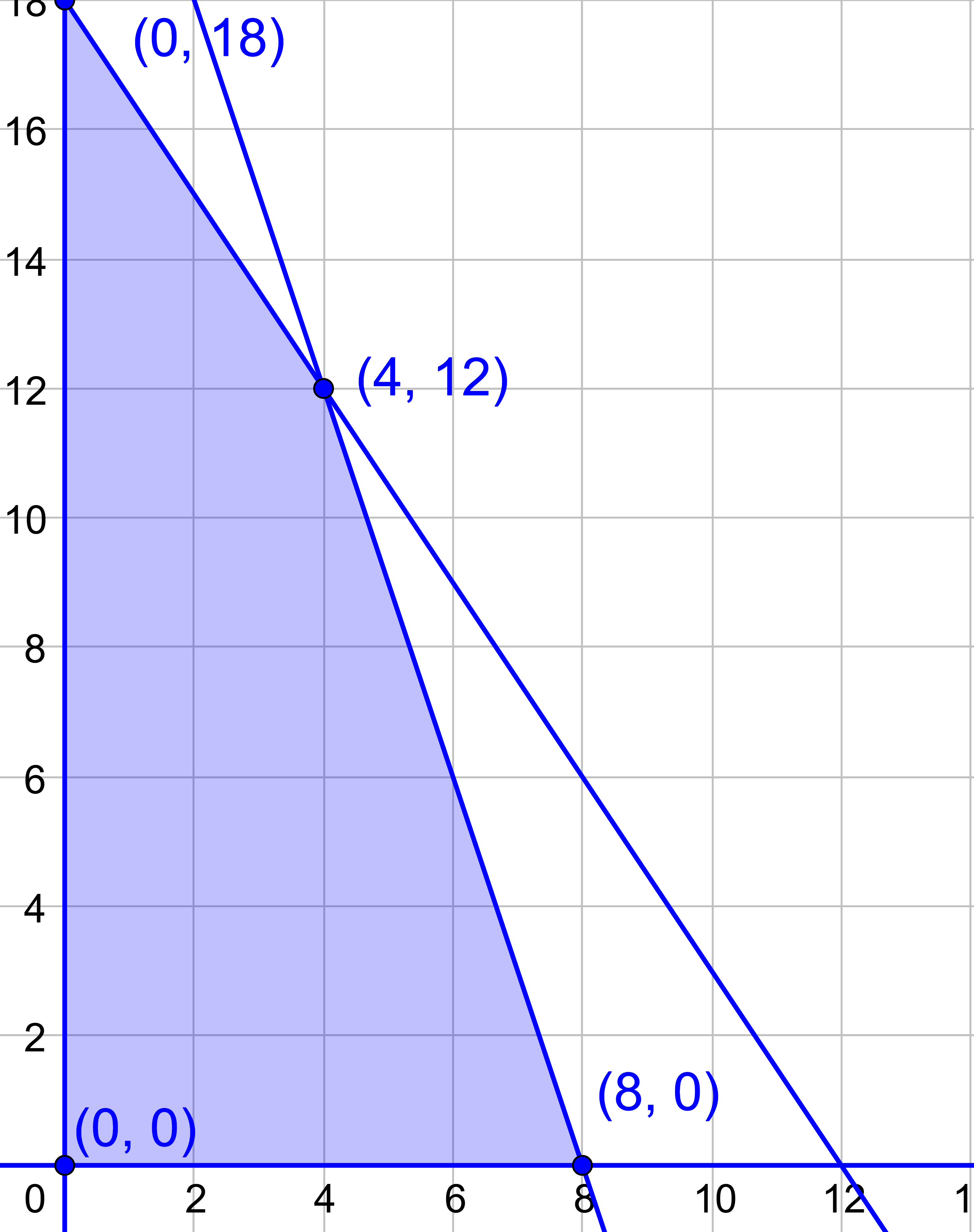
The objective function is the profit. From the table, the profit is P = 30x + 20y. Plug in the vertices to find the maximum profit.
Try (0, 0).
P = 30x + 20y
P = 30(0) + 20(0)
P = 0
That was not surprising because it they make nothing, then they get no profit. Next try (8, 0).
P = 30x + 20y
P = 30(8) + 20(0)
P = 240
Try (4, 12).
P = 30x + 20y
P = 30(4) + 20(12)
P = 360
Try (0, 18).
P = 30x + 20y
P = 30(0) + 20(18)
P = 360
Two vertices gave the same maximum of 360. That means that any point along that line on the side of the shaded area will give 360 when plugged into the objective function. The furniture company then needs to make a decision. They probably should make both chairs and tables so that they do not rely on only one product in case the market changes. Thus, they should produce 4 ornate chairs and 12 fancy tables a day to earn a profit of $360.
A calculator company makes blue scientific calculators and red scientific calculators. They can make a maximum of 500 calculators total a day. They only have enough dye to make up to 200 blue calculators. They can only make up to 400 red calculators. The profit for the calculators is $8 for a blue and $7 for a red. Use linear programming to maximize the profit.
Solution
Make 200 blue calculators and 300 red calculators for a profit of $3700.
Helpful videos about this lesson.
